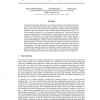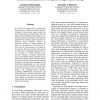153 search results - page 2 / 31 » Unsupervised Learning of Name Structure From Coreference Dat... |
NIPS
2007
13 years 6 months ago
2007
Unsupervised learning algorithms aim to discover the structure hidden in the data, and to learn representations that are more suitable as input to a supervised machine than the ra...
CICLING
2009
Springer
14 years 5 months ago
2009
Springer
We cast name discrimination as a problem in clustering short contexts. Each occurrence of an ambiguous name is treated independently, and represented using second?order context vec...
CORR
2007
Springer
13 years 4 months ago
2007
Springer
Data mining allows the exploration of sequences of phenomena, whereas one usually tends to focus on isolated phenomena or on the relation between two phenomena. It offers invaluab...
CORR
2010
Springer
13 years 3 months ago
2010
Springer
Learning structured representations has emerged as an important problem in many domains, including document and Web data mining, bioinformatics, and image analysis. One approach t...
EMNLP
2008
13 years 6 months ago
2008
We describe an approach for acquiring the domain-specific dialog knowledge required to configure a task-oriented dialog system that uses human-human interaction data. The key aspe...


